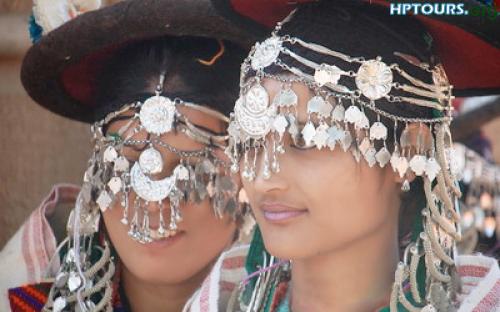The present day the Kinnauras do not constitute a homogenous group and display significant territorial and ethnic diversity. For a better understanding of ethnic and cultural distribution, the Kinnaur District may be classified into three territorial units.
Lower Kinnaur comprise area between Chora at the boundary of the Kinnaur District with Rampur Bushahr and Kalpa including Nichar and Sangla valleys. The people of Lower Kinnaur are primarily of the Mediterranean physical type. It is difficult to distinguish them from the people residing in the adjoining Shimla District with whom they have some affinity. The people of lower Kinnaur are mostly Hindus though the ethno-historical factors have resulted in some Buddhist influence.
The people of middle Kinnaur are of mixed racial strain. Some have marked Mongoloid and others marked Mediterranean features. In some cases there is an admixture of the above two in varying degrees. The inhabitants are Buddhist as well as Hindus. Many people have faith in both the religions. The upper Kinnaur comprises of remaining north-eastern part of the district i.e. the area between Pooh and Hangrang valley extending upto international border with Tibet.
The predominant physical type of upper Kinnaur in the Mongoloid though a few persons with Mediterrean features are also seen in the area around Pooh. Some persons show the blending of Mediterrean and Mongoloid elements in varying degrees. However the people of Hangrang valley are almost universally Mongoloids. They mostly follow Mahayana Buddhist religion.
The Kinnaur society is divided into two broad occupational groups- peasants and the artisans possibly of diverse ethnic origin. These groups are represented by Kanets (Rajputs) and Scheduled Castes.
The Kanets comprise the main cultivating community of the area and use honorific surname Negi. Among the Kanets there are three grades. In the first grade Kanets there are as many as fifty sub-castes, in the second grades there are seventeen sub-castes and in the third grade who work as potter have three sub-castes. Waza Kanets belong to the third grade and are considered inferior among Kanets.
The Scheduled castes include Chamangs and Domangs. Chamangs traditionally make and wove clothes. The Domangs are primarily blacksmiths. There is a third caste called ores. The main profession of Ores is carpentry. In social status the Ores are equal to Domangs. Among the Scheduled castes blacksmiths and carpenters i.e. Domangs and Ores considered themselves superior to Kolis or Chamangs--










Comment with Facebook Box